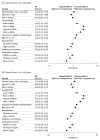Assessment of the Association of Vitamin D Level With SARS-CoV-2 Seropositivity Among Working-Age Adults
- PMID: 34009346
- PMCID: PMC8135000
- DOI: 10.1001/jamanetworkopen.2021.11634
Assessment of the Association of Vitamin D Level With SARS-CoV-2 Seropositivity Among Working-Age Adults
Abstract
Importance: Low vitamin D levels have been reported to be associated with increased risk of SARS-CoV-2 infection. Independent, well-powered studies could further our understanding of this association.
Objective: To examine whether low levels of vitamin D are associated with SARS-CoV-2 seropositivity, an indicator of previous infection.
Design, setting, and participants: This is a cohort study of employees and spouses who elected to be tested for SARS-CoV-2 IgG as part of an annual employer-sponsored health screening program conducted in August to November 2020. This program includes commonly assessed demographic, biometric, and laboratory variables, including total vitamin D measurement. Baseline (prepandemic) levels of vitamin D and potential confounders were obtained from screening results from the previous year (September 2019 to January 2020). Data analysis was performed from December 2020 to March 2021.
Exposures: Low total serum 25-hydroxyvitamin D, defined as either less than 20 ng/mL or less than 30 ng/mL.
Main outcomes and measures: The main outcome was SARS-CoV-2 seropositivity, as determined with US Food and Drug Administration emergency use-authorized assays. The association of SARS-CoV-2 seropositivity with vitamin D levels was assessed by multivariable logistic regression analyses and propensity score analyses.
Results: The 18 148 individuals included in this study had test results for SARS-CoV-2 IgG in 2020 and vitamin D levels from the prepandemic and pandemic periods. Their median (interquartile range) age was 47 (37-56) years, 12 170 (67.1%) were women, 900 (5.0%) were seropositive, 4498 (24.8%) had a vitamin D level less than 20 ng/mL, and 10 876 (59.9%) had a vitamin D level less than 30 ng/mL before the pandemic. In multivariable models adjusting for age, sex, race/ethnicity, education, body mass index, blood pressure, smoking status, and geographical location, SARS-CoV-2 seropositivity was not associated with having a vitamin D level less than 20 ng/mL before (odds ratio [OR], 1.04; 95% CI, 0.88-1.22) or during (OR, 0.93; 95% CI, 0.79-1.09) the pandemic; it was also not associated with having a vitamin D level less than 30 ng/mL before (OR, 1.09; 95% CI, 0.93-1.27) or during (OR, 1.05; 95% CI, 0.91-1.23) the pandemic. Similar results were observed in propensity score analyses. SARS-CoV-2 seropositivity was associated with obesity (OR, 1.26; 95% CI, 1.08-1.46), not having a college degree (OR, 1.40; 95% CI, 1.21-1.62), and Asian (OR, 1.46; 95% CI, 1.13-1.87), Black (OR, 2.74; 95% CI, 2.25-3.34), Hispanic (OR, 2.65; 95% CI, 2.15-3.27), American Indian or Alaska Native, and Native Hawaiian or other Pacific Islander (OR, 2.01; OR, 1.54-2.62) race/ethnicity, and was inversely associated with high blood pressure (OR, 0.82; 95% CI, 0.70-0.96), smoking (OR, 0.60; 95% CI, 0.47-0.78), and residing in the US Northeast (OR, 0.75; 95% CI, 0.62-0.92) and West (OR, 0.54; 95% CI, 0.44-0.67).
Conclusions and relevance: In this cohort study, SARS-CoV-2 seropositivity was not associated with low levels of vitamin D independently of other risk factors.
Conflict of interest statement
Figures


Comment in
-
Reassessing the Association of Vitamin D Level With SARS-CoV-2 Seropositivity.JAMA Netw Open. 2021 May 3;4(5):e2111750. doi: 10.1001/jamanetworkopen.2021.11750. JAMA Netw Open. 2021. PMID: 34009353 No abstract available.
References
MeSH terms
Substances
LinkOut - more resources
Full Text Sources
Other Literature Sources
Medical
Miscellaneous

